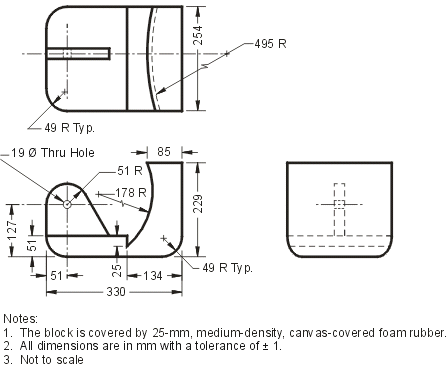|
|
 |
Revised: January 2006
Issued: December 1996

Disclaimer
The documents in HTML format that are provided on this Web site have been
prepared for use as a ready reference and do not have legal force or effect.
A Portable Document Format (PDF) version is provided for the purposes of
interpretation and application. The PDF version may be viewed using version
3.0 or higher of the Adobe® Acrobat Reader, which may be downloaded
free of charge by visiting the
Adobe® Web site. |


1.
|
Introduction
Test Method 210 — Seat Belt Anchorages (January 2006) is to be
used for demonstrating compliance with the requirements of section
210 of Schedule IV to the Motor Vehicle Safety Regulations.
|
(Original signed by)
Director, Standards Research and Development
for the Minister of Transport,
Infrastructure and Communities
Ottawa, Ontario
|
2.
|
Strength Test Conditions
2.1 Anchorages for a Type 1 Seat Belt Assembly
or the Pelvic Portion of a Type 2 Seat Belt Assembly that is Equipped
with a Detachable Upper Torso Restraint
2.1.1 The strength of the anchorages for a Type 1 seat belt assembly
or the pelvic portion of a Type 2 seat belt assembly that is equipped
with a detachable upper torso restraint shall be tested
(a) by placing the seat in its rearmost position on a plane parallel
to the longitudinal centreline of the vehicle,
(b) by positioning the pelvic body block illustrated in Figure 1
as specified in subsection 2.3 and by restraining the pelvic body block
by:
(i) a Type 1 seat belt assembly,
(ii) the pelvic portion of a Type 2 seat belt assembly, or
(iii) material whose breaking strength is equal to or greater
than the breaking strength of the webbing for the seat belt assembly
that was installed as original equipment at that seating position,
provided that, at the initiation of the test, the geometry and the
attachment duplicate those of the originally installed seat belt assembly,
and
(c) by applying and maintaining a force of 22 241 N to
the pelvic body block for 10 seconds in the direction in which
the seat faces,
(d) with the initial application angle of the force being not less
than 5° and not more than 15° above the horizontal plane and
(e) with the onset rate of the force being not more than 222 411 N/s
so as to attain the 22 241-N force in not more than 30 seconds.
|

Figure 1 — Body Block for the Lap Belt Anchorage
| |
2.1.2 Alternative Pelvic Body Block
In order to apply a force to the centre set of anchorages for a group
of three or more adjacent sets of anchorages, the alternative pelvic body
block illustrated in Figure 2 may, at the option of the manufacturer,
be substituted for the pelvic body block illustrated in Figure 1.
|

Figure 2 — Alternative Body Block for Centre Positions
| |
2.2 Anchorages for the Pelvic Portion and the
Upper Torso Portion of a Type 2 Seat Belt Assembly
2.2.1 The strength of the anchorages for the pelvic portion and the
upper torso portion of a Type 2 seat belt assembly shall be tested
(a) by placing the seat in its rearmost position on a plane parallel
to the longitudinal centreline of the vehicle,
(b) by positioning the body block as specified in subsection 2.3
and by restraining the pelvic body block by a Type 2 seat belt
assembly as follows:
(i) the pelvic body block illustrated in Figure 1 or, for a centre
seating position, at the option of the manufacturer, the alternative
pelvic body block illustrated in Figure 2 and
(ii) the upper torso body block illustrated in Figure 3,
(c) by applying and maintaining a force of 13 345 N simultaneously
to each body block for 10 seconds in the direction in which the
seat faces,
(d) with the initial application angle of the force being not less
than 5° and not more than 15° above the horizontal plane,
and
(e) with the onset rate of the force being not more than 133 447 N/s
so as to attain the 13 345-N force in not more than 30 seconds.
|

Figure 3 — Body Block for a Combination Shoulder-and-Lap-Belt Anchorage
| |
2.3 Adjustment in the Case of Interference between
the Pelvic Body Block and the Belt Buckle
2.3.1 Place a 50th percentile adult male anthropomorphic
test device (ATD) at each seating position and fasten the seat belt around
it, removing all slack from the webbing. Place a mark on the seat belt
webbing to indicate how far the seat belt extends from the retractor.
Unbelt and remove the ATDs from the vehicle.
2.3.2 Place the body blocks against the back of the seat and fasten
the seat belts around them. If, at this position, the belt buckle appears
to be susceptible to damage from the test loads, move the body blocks
forward, but not further than the mark made by following the procedure
specified in subsection 2.3.1, in order to minimize the likelihood of
buckle damage.
|
|





